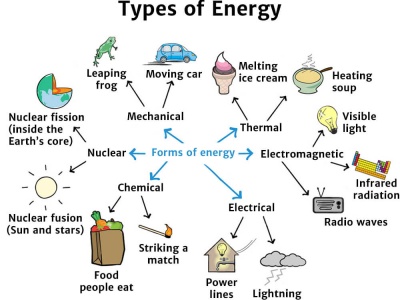Energy Transformations - Weekly Blog (1/28-2/1)
 |
| Types of Energy by Solar Schools |
Summary:
You've probably heard the quote by Albert Einstein, "Energy cannot be created or destroyed, it can only be changed from one form to another." But what are the forms of energy? There are six general energy forms: chemical, mechanical, thermal, light, electrical, and nuclear. Any form of energy can be converted into another form. There are many examples of energy transformations that happen in our everyday lives.
The first energy form is chemical energy. Chemical energy is a form of potential energy and is stored in chemical substances. An example of chemical energy is gasoline that is used to power a car. The next form of energy is mechanical energy. Mechanical energy is energy released by a moving object. For example, mechanical energy is the energy that causes a soccer ball to move when kicked. Another form of energy is thermal energy and is associated with the motion of molecules. This means that it is caused by friction from molecules rubbing against each other. An example of thermal energy is rubbing your hands against each other to get warm.
The fourth form of energy is known as light energy. It is a form of electromagnetic energy. Examples of light energy include x-rays, radio waves, and more. The next form of energy is electrical energy and is associated with the movement of electrons. Some examples of electrical energy include televisions, cd players, and more. The last form of energy is nuclear energy. This type of energy is stored in the nucleus of an atom. The nucleus is split, and energy is released. This is known as fission. Energy can also be released if the nucleus is fused together, known as fusion.
Comments
Post a Comment